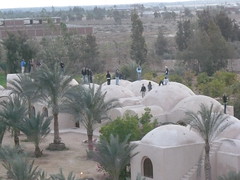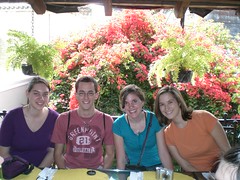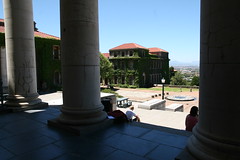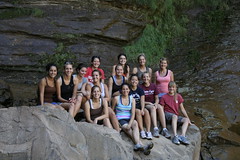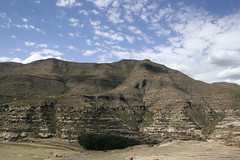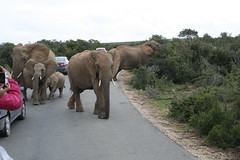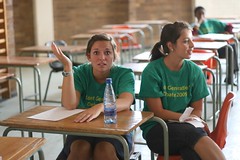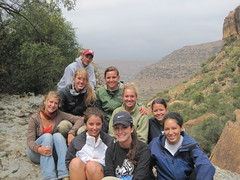 Our first church experience in Lesotho was probably the most memorable. We were to be sitting through 1.5 hours of a four hour service. We all met together and walked through town to the outskirts of the village to a small rectangular hut on the side of the mountain. All 24 students and 3 leaders piled into a room with about 10-15 congregation members. There was a small candle burning in the middle of the floor while we all lined up against the walls. The small room was dark and muggy and there were two small windows. We clapped along with the lively music of the congregation while someone beat a drum as four people ran around the candle in the middle of the room singing and clapping, raising their arms in the air praising and worshipping the Lord. On several occasions a few of us were coaxed into the middle of the floor to run about and clap with the members.
Our first church experience in Lesotho was probably the most memorable. We were to be sitting through 1.5 hours of a four hour service. We all met together and walked through town to the outskirts of the village to a small rectangular hut on the side of the mountain. All 24 students and 3 leaders piled into a room with about 10-15 congregation members. There was a small candle burning in the middle of the floor while we all lined up against the walls. The small room was dark and muggy and there were two small windows. We clapped along with the lively music of the congregation while someone beat a drum as four people ran around the candle in the middle of the room singing and clapping, raising their arms in the air praising and worshipping the Lord. On several occasions a few of us were coaxed into the middle of the floor to run about and clap with the members.
The pastor delivered a kind and passionate message in seSotho while Harlan translated the key points for us. He then asked us if two or three people would step forward and share their brief testimonies. As Darrel and Nils spoke I looked around and noticed the looks of intrigue that all members of the congregation were showing. Everyone was so interested in knowing about us and why we had come to their small, primitive village for two and a half weeks and what we thought of them and their country. When each testimony had finished everyone smiled and clapped. We sang some of our songs for them and then entered prayer time. Three people could come and kneel on the floor while the pastor and his associates would lay a bible or a small metal cross on the backs of the people while praying fervently, eyes shut, heads tilted back, voices raised. Almost all of us knelt down and experienced one of these powerful moments.
Churches like this believe that through worship, prayer, singing, and dancing, that one can open up their soul to be cleansed by God. There is so much passion here in the services in Lesotho, and everyone feels free to let loose during the service, doing whatever it takes to rid themselves of stresses and burdens. I left that day feeling refreshed by the passion and love of the people of Lesotho. By praising with such vigor and abandon, one feels closer to God.
– Curtis Reesor
 Building Relationships with my host family was one of my favorite aspects of our homestay in Lesotho. My family was fairly small. My ‘me (mother) Malekau has three children: Lekau(19), Mpho(9), and Mamococho(21). She also has a helper named Nopi (21) who was around the house. My family lives in an extremely small, two room house, and they own very few material possessions; however, they are rich in so many other ways. They taught me to take joy and happiness from the simple things in life. We spent hours in the evening over candlelight playing cards, dancing, singing, talking, and laughing until we cried. We used ate papa (cooked white maize meal) and cooked spinach, occasionally having eggs or chicken. They also made many kinds of bread for us.
Building Relationships with my host family was one of my favorite aspects of our homestay in Lesotho. My family was fairly small. My ‘me (mother) Malekau has three children: Lekau(19), Mpho(9), and Mamococho(21). She also has a helper named Nopi (21) who was around the house. My family lives in an extremely small, two room house, and they own very few material possessions; however, they are rich in so many other ways. They taught me to take joy and happiness from the simple things in life. We spent hours in the evening over candlelight playing cards, dancing, singing, talking, and laughing until we cried. We used ate papa (cooked white maize meal) and cooked spinach, occasionally having eggs or chicken. They also made many kinds of bread for us.
My family does not have it easy; the father died in 2001 from a mining accident, and our mother has raised the family since then, while teaching first grade full time. She gets paid very little and teaches 40 students, but I have never heard her complain. They took us in and loved us like family, and it was definitely hard for Denay and me to leave.
– Maria Yoder
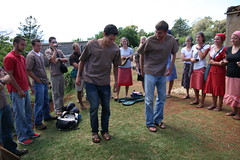 Richard Mohale, age 19, is a very talented young man. As his host brother, I was able to get to know him very well. By the time the two and a half weeks were through, I felt like we were truly brothers. Richard showed us what village life was about. He is captain of Malealea Lilala FC, the village soccer team, and his goal is to sometime try out for the Bloemfontein Celtics, a team in the South African premier league. Because of his goal, he has changed his lifestyle. He has stopped smoking and drinking altogether, and knows that Malealea village has nothing to offer him in the years to come, so soccer is his way out.
Richard Mohale, age 19, is a very talented young man. As his host brother, I was able to get to know him very well. By the time the two and a half weeks were through, I felt like we were truly brothers. Richard showed us what village life was about. He is captain of Malealea Lilala FC, the village soccer team, and his goal is to sometime try out for the Bloemfontein Celtics, a team in the South African premier league. Because of his goal, he has changed his lifestyle. He has stopped smoking and drinking altogether, and knows that Malealea village has nothing to offer him in the years to come, so soccer is his way out.
Not only is he the best player in the village, he is also one of the best dancers. In 2003 at the age of 13, Richard was able to experience another part of the world as a member of the Malealea Band, traveling to England and Australia to perform. The band plays with homemade guitars, violins, and drums. These instruments, combined with singing and traditional Basotho dance, create a one of a kind sight and sound. With plenty of free time, Richard was able to teach Justin and me the basic steps. We would practice two times a day, sometimes having an audience who mostly just laughed at us.
Another role Richard has in life is to be the male influence on his three year old nephew. His brother left for Capetown one and a half years ago in search of a job and has not been able to visit since then. Richard may only be nineteen, but village life has forced him to grow up faster. His own father died three and a half years ago because he was under the control of a witch. Disbelief is still evident in the Mohale house. There are small sticks placed in the rafters to prevent a witch from taking control. The beds in the house are also raised to prevent the Tokolosi, small people sent by the witch, from being able to reach you in your sleep. It is believed that Richard’s father was killed by a witch because the clinic could not figure out his sickness and none of the modern medication worked. The belief in witches is still a part of everyday life in Basotho culture.
– Jason Ropp
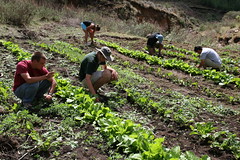 Since we left the “kingdom in the sky” a week and a half ago, we have embarked upon an exciting new phase in our trip. After a refreshingly delicious meal of steak, beans, and chocolate cake at the lodge, our group traveled to the small, rural town of Bethulie, with a population of 500 whites and 5000 blacks, most of whom still live in the “location” just outside of town. We reveled in the conveniences of running water, hot showers, electricity, and the ability to contact home for the first time in a month. We studied the town’s local history, especially the Afrikaner side of things, by visiting the prison, the local schools, nursing home, police station, and the memorial for the Afrikaner women and children killed in the concentration camps.
Since we left the “kingdom in the sky” a week and a half ago, we have embarked upon an exciting new phase in our trip. After a refreshingly delicious meal of steak, beans, and chocolate cake at the lodge, our group traveled to the small, rural town of Bethulie, with a population of 500 whites and 5000 blacks, most of whom still live in the “location” just outside of town. We reveled in the conveniences of running water, hot showers, electricity, and the ability to contact home for the first time in a month. We studied the town’s local history, especially the Afrikaner side of things, by visiting the prison, the local schools, nursing home, police station, and the memorial for the Afrikaner women and children killed in the concentration camps.
After this, we stayed with families for two nights, immersing ourselves over the weekend in what it felt like to live in a rural, largely agricultural community which was still changing from apartheid into modern South Africa. Then we traveled to Addo Elephant Park, where we were able to tour on a safari for the afternoon. The elephants came so close we could have touched them (although we were strongly encouraged not to), and we also saw kudu, lions, jackels, eland, warthog, and many other fantastic sights.
Since then, we have been staying in the beach town of Plettenberg Bay, a beautiful place right on the “Sunshine Coast.” And yesterday, over half our group took the plunge…and bungee jumped off of the highest bridge in the world, almost 220 m. Thankfully, everyone made it back to firm ground safely. Some of us are leaving for a week of free travel today, while the others will leave tomorrow for such places as Wilderness Bay, Buffel Bay, and Stellenbosch.
– Michael Spory and Katie Rodriguez
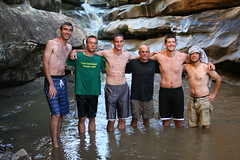 Lesotho has some amazing landscape. Everywhere you look there are mountains, valleys and rivers. Thanks to this incredible landscape, we were never short of hiking options. Whether it was hiking down the river to work on our tan or hiking two hours to a waterfall, it was always an adventure.
Lesotho has some amazing landscape. Everywhere you look there are mountains, valleys and rivers. Thanks to this incredible landscape, we were never short of hiking options. Whether it was hiking down the river to work on our tan or hiking two hours to a waterfall, it was always an adventure.
Some of our hikes included hiking an hour down hill to a swimming hole, only to hike back uphill twenty minutes later. Hiking an hour and a half up the only road to the “Gates of Paradise,” along the way passing a sign that said ‘13,335 kms to New York.’ I don’t know if it counts as a hike, but riding a horse on a two hour pony trek, which sure felt like a hike after we got off the horses!
But my favorite hike was a hike that Harlan referred to as the “All Wet Hike.” This hike included hiking down a gorge, then walking in the river to a waterfall, then jumping in the water and climbing up the waterfall, and then coming back down the same way you went up. The hike ended with a straight up scramble to the top of the mountain.
Every time we got to the top of a hill or mountain, I felt like I should break out in “the hills are alive with the sound of music…” But instead I found myself doubled over gasping for air. (I don’t know how Julie Andrews does it). Every challenging hike had its reward… a spectacular view of some of God’s amazing world.
– Michael Erb
 Chichicastenango: a tourist trap, but a necessary trap. On Friday night a group of us, Brent, Allison, Stacy, and me, just to name a few were walking down the streets of Chichi when an indigenous woman, Manuela, and her daughter, Elena, invited us to her house. So being the ignorant people we were we went to their house assuming that they wanted to talk to us and just establish a relationship type thing. It turns out she wanted us to buy from her, but despite the insistence that we buy from her, we got to play with a few of her nine kids. My favorite moment was when we were leaving and the smallest kid, 2 yrs. old?, ran after me trying to hug my legs good bye. I picked him up and he clung to me. I was amazed with how much trust, how much joy this kid had in me, a stranger, an alien who he had only known for a few minutes.
Chichicastenango: a tourist trap, but a necessary trap. On Friday night a group of us, Brent, Allison, Stacy, and me, just to name a few were walking down the streets of Chichi when an indigenous woman, Manuela, and her daughter, Elena, invited us to her house. So being the ignorant people we were we went to their house assuming that they wanted to talk to us and just establish a relationship type thing. It turns out she wanted us to buy from her, but despite the insistence that we buy from her, we got to play with a few of her nine kids. My favorite moment was when we were leaving and the smallest kid, 2 yrs. old?, ran after me trying to hug my legs good bye. I picked him up and he clung to me. I was amazed with how much trust, how much joy this kid had in me, a stranger, an alien who he had only known for a few minutes. I have been on foreign soil now for a little over two weeks, and it seems as just yesterday I was stepping off the plane diving into a new experience full of unknowns. For the little time I’ve been here, Guatemala makes me appreciate all God has blessed me with back home.
I have been on foreign soil now for a little over two weeks, and it seems as just yesterday I was stepping off the plane diving into a new experience full of unknowns. For the little time I’ve been here, Guatemala makes me appreciate all God has blessed me with back home.
